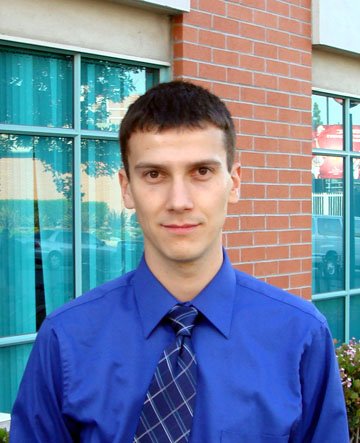Today, I attended Tom Mitchell's talk. This was perhaps the best research I have seen in 6-7 years. If you have a moment, I encourage you to take a look at his paper summarizing this work.
In short, they found that when a person thinks about some noun, some parts of that person's brain get increased blood flow. It turns out that:
1. The parts of YOUR brain that increase blood flow are so similar to the parts of MY brain that increase blood flow, that I can build a machine learner to learn what brain states map to what nouns based on YOUR brain and then be able to predict what nouns I am thinking about based on pictures of MY brain.
2. By looking at what verbs are most commonly used (on the Internet) in combination with a set of nouns, taking proportional linear combinations of brain pictures for certain nouns allows correct predictions of brain pictures for other nouns.
Thursday, March 26, 2009
Saturday, March 21, 2009
Push vs. Pull advising
Over the years, I've had several academic advisors and mentors. I've noticed that one of the dimension among which such advisors can be classified is what I call the push vs. pull dimension that measures the method by which they collect information about their advisees. In the extremes, a push advisor waits for a student to come to him or her with a report of progress or a problem, and only then evaluates the information and advises, while a pull advisor checks with the student on a regular basis (e.g., at a weekly one-on-one meeting), collects information, and advises.
My observation, that I put up for debate here, is that the majority of academic advisors are primarily pull advisors who employ push mechanisms when it seems appropriate. I claim that a better advisor is, instead, one who is primarily a push advisor, employing pull mechanisms when appropriate.
It is unlikely that any one advisor is completely push (e.g., if a student, for months, doesn't produce any results, questions, or thoughts, the advisor is sure to inquire what's going on) or completely pull (at times, e.g., around deadlines, weekly, or even daily updates are insufficient, and the advisor needs to know right away when the student finishes a task). However, in my experience, the majority of academic advisors are primarily pull advisors, trying to guide progress via holding weekly individual meetings with each student.
Push and pull mechanisms are not new to engineers and thus we know some of their advantages and disadvantages. In particular, pull mechanisms are inefficient when the frequency of updates is erratic. If a student sometimes finishes tasks daily but has to wait up to a week to discuss the progress with the advisor before making future progress, much time is wasted. On the other hand, frequent push updates can render the advisor unable to multitask and, among other tasks, advise multiple students. The main flaw with pull advising is that it affects the student's schedule and planning practices: as many students are are deadline-driven creatures, if faced with weekly meetings, each tasks tends to occupy one week, regardless of its difficulty. A task's completion time should be independent of the pull schedule, and the student should be able to seek advice when it is necessary, not when the clock strikes seven [days]. Thus, an advisor should be a push advisor, switching to pulling only when (1) pushing is so frequent that it interferes with progress or (2) pushing is so infrequent that it indicates the misuse of the student's resources.
My observation, that I put up for debate here, is that the majority of academic advisors are primarily pull advisors who employ push mechanisms when it seems appropriate. I claim that a better advisor is, instead, one who is primarily a push advisor, employing pull mechanisms when appropriate.
It is unlikely that any one advisor is completely push (e.g., if a student, for months, doesn't produce any results, questions, or thoughts, the advisor is sure to inquire what's going on) or completely pull (at times, e.g., around deadlines, weekly, or even daily updates are insufficient, and the advisor needs to know right away when the student finishes a task). However, in my experience, the majority of academic advisors are primarily pull advisors, trying to guide progress via holding weekly individual meetings with each student.
Push and pull mechanisms are not new to engineers and thus we know some of their advantages and disadvantages. In particular, pull mechanisms are inefficient when the frequency of updates is erratic. If a student sometimes finishes tasks daily but has to wait up to a week to discuss the progress with the advisor before making future progress, much time is wasted. On the other hand, frequent push updates can render the advisor unable to multitask and, among other tasks, advise multiple students. The main flaw with pull advising is that it affects the student's schedule and planning practices: as many students are are deadline-driven creatures, if faced with weekly meetings, each tasks tends to occupy one week, regardless of its difficulty. A task's completion time should be independent of the pull schedule, and the student should be able to seek advice when it is necessary, not when the clock strikes seven [days]. Thus, an advisor should be a push advisor, switching to pulling only when (1) pushing is so frequent that it interferes with progress or (2) pushing is so infrequent that it indicates the misuse of the student's resources.
Subscribe to:
Posts (Atom)



